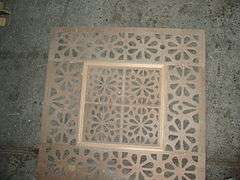Fretwork
Fretwork is an interlaced decorative design that is either carved in low relief on a solid background, or cut out with a fretsaw, coping saw, jigsaw or scroll saw. Most fretwork patterns are geometric in design. The materials most commonly used are wood and metal.[1] Fretwork is used to adorn furniture and musical instruments. The term is also used for tracery on glazed windows and doors. Fretwork is also used to adorn/decorate architecture, where specific elements of decor are named according to their use such as eave bracket, gable fretwork or baluster fretwork, which may be of metal, especially cast iron or aluminum.
Fretwork patterns originally were ornamental designs used to decorate objects with a grid or a lattice. Designs have developed from the rectangular wave Greek fret to intricate intertwined patterns. A common misconception is that fretwork must be done with a fretsaw. However, a fretwork pattern is considered a fretwork whether or not it was cut out with a fretsaw.
Computer numerical control (CNC) has brought about change in the method of timber fretwork manufacture. Lasers or router/milling cutting implements can now fashion timber and various other materials into flat and even 3D decorative items.
Gallery
 Gable end fretwork
Gable end fretwork Timber fretwork
Timber fretwork Fretwork for a ventilation or light grill
Fretwork for a ventilation or light grill Gable end Fretwork
Gable end Fretwork
References
- Olver, Elizabeth (2001), Jewelry Making Techniques Book, North Light Books, p. 26, ISBN 978-1-58180-210-8.
External links
| Wikimedia Commons has media related to Fretwork. |